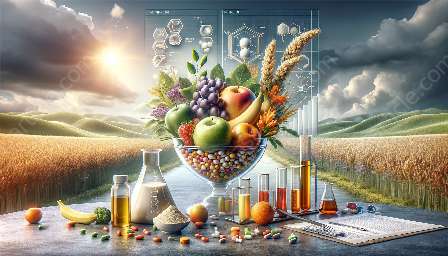As we age, the role of nutrition becomes increasingly important in maintaining overall health and well-being. Nutrient interactions play a crucial role in the aging process, impacting various aspects of cellular and physiological functions. This topic cluster explores the dynamic relationship between nutrient interactions and the aging process and their impact on nutrition science.
The Role of Nutrient Interactions in Aging
Before delving into specific nutrient interactions, it's important to understand the broader role of nutrients in the aging process. Nutrients, including vitamins, minerals, and other bioactive compounds, serve as essential components for various physiological processes that support overall health and longevity.
As we age, the body's nutrient requirements may change, and the interplay between different nutrients becomes increasingly significant. Nutrient interactions influence cellular processes such as oxidative stress, inflammation, and DNA repair, all of which are closely associated with aging and age-related conditions.
Key Nutrients and Their Interactions in Aging
Several key nutrients have been identified for their roles in promoting healthy aging and longevity. Understanding the interactions between these nutrients can provide valuable insights into developing effective nutritional strategies for supporting the aging population.
1. Antioxidant Nutrients
Antioxidant nutrients, such as vitamin C, vitamin E, and selenium, play a critical role in combating oxidative stress, a key contributor to aging processes. These nutrients work synergistically to neutralize free radicals and reduce cellular damage, thereby supporting healthy aging.
2. Omega-3 Fatty Acids
The interaction between omega-3 fatty acids, particularly eicosapentaenoic acid (EPA) and docosahexaenoic acid (DHA), is essential in modulating inflammation and maintaining optimal brain function in aging individuals. These fatty acids also contribute to cardiovascular health and cognitive function, both of which are important aspects of healthy aging.
3. B-vitamins
B-vitamins, including folate, vitamin B6, and vitamin B12, interact with each other and with other nutrients to support energy metabolism, DNA synthesis, and the maintenance of a healthy nervous system. Deficiencies in these B-vitamins can accelerate aging-related processes and increase the risk of age-related neurological disorders.
4. Minerals
Minerals such as calcium, magnesium, and zinc interact with other nutrients to support bone health, muscle function, and immune system integrity. The intricate interplay between these minerals and other nutrients is vital for maintaining the structural integrity of tissues and organs as the body ages.
Implications for Nutrition Science
Studying nutrient interactions involved in the aging process has significant implications for nutrition science. By unraveling the complexities of how different nutrients interact and influence aging-related pathways, researchers can develop targeted dietary interventions and personalized nutrition recommendations for promoting healthy aging.
1. Personalized Nutrition Approaches
Understanding nutrient interactions in the context of aging allows for the development of personalized nutrition approaches tailored to the specific needs of aging individuals. Personalized nutrition considers factors such as genetic variations, lifestyle, and age-related changes in nutrient metabolism to optimize health outcomes in older adults.
2. Functional Foods and Nutraceuticals
Insights into nutrient interactions in aging pave the way for the development of functional foods and nutraceuticals designed to deliver targeted combinations of nutrients that synergistically support aging-related processes. These innovative products offer potential solutions to address age-related nutritional challenges and promote healthy aging.
3. Nutritional Interventions for Age-Related Conditions
By understanding the nuanced interactions between nutrients and their impact on aging processes, nutrition science can identify potential interventions to mitigate the risk of age-related conditions such as cardiovascular disease, cognitive decline, and musculoskeletal disorders. Targeted nutritional strategies can contribute to improved quality of life and longevity in aging individuals.
Conclusion
Nutrient interactions involved in the aging process represent a fascinating and crucial area of study within nutrition science. By recognizing the dynamic relationships between key nutrients and their impact on aging-related pathways, researchers and healthcare professionals can advance our understanding of how nutrition influences healthy aging. This deeper understanding offers the potential to drive innovative nutritional strategies and interventions that support the well-being of aging individuals.

